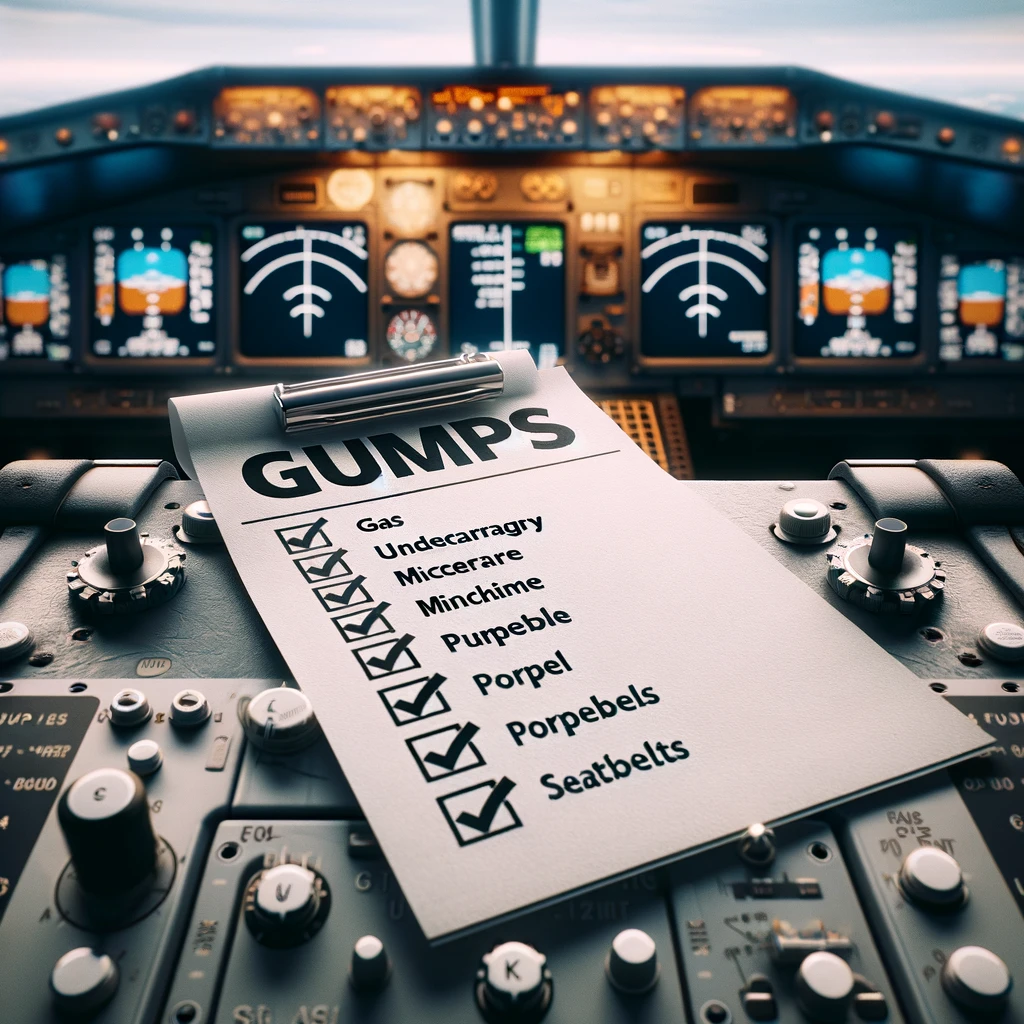Aviation is an industry where tiny things can become critical because these can result in either the loss of lives or flight. Along with the other safety measures and checklists, the ‘GUMP check’ is one of the most crucial points to be noted by every pilot, whether a beginner or an experienced pilot; mastering the Guidelines of GUMPS Checklist is essential, vital, and appropriate for safe flying management.
We will dive into the GUMPS checklist manifesto in aviation, starting with its explanation, reason for existence, and otherwise perfect execution.
Understanding the GUMPS Checklist:
Imagine that you are flying a plane, and after an amazing flight, you have to land at your destination. And your destination is right below you and you are already prepared for the decline. This is where GUMPS goes into action. GUMPS checklist is a pilot’s acronym commonly used during the landing phase, to verify various aircraft requirements before touchdown. It signifies ‘Gas,’ ‘Undercarriage,’ ‘Mixture,’ ‘Prop,’ and ‘Safety.’
Every item on the GUMPS checklist is an important kind of in-flight system that needs proper testing and examination. Knowing that everything from fuel to landing gear & engine check is properly set, it is not just about some basic steps of operational preparedness – it is about protecting lives, as a single problem in any of these can make your landing the worst circumstance you ever imagine or the last one.
Breakdown of GUMPS Components:
- “G” stands for “Gas”: This initial step ensures that the aircraft’s fuel system draws from the right tank, with the fuel selector set appropriately and the fuel pump engaged for a smoother fuel flow.
- “U” stands for “Undercarriage”: Often the most visible, in this step pilot checks that the landing gear is in an appropriate position—down for landing or safely retracted in the airborne phase.
- “M” stands for “Mixture and Manifold”: The Mixture control regulates the air-fuel ratio for piston-engine aircraft. If the ratio is too low, then the plane will consume more fuel & and it may also cause issues in the plane engine, which may result in engine failure. if the ratio exceeds the normal limits, the engine will start knocking, as the engine will start taking more air and less fuel.
- “P” stands for Propeller: This step ensures that your propeller is set in the right direction, flat when preparing to land, and down when slowing down for descent and landing.
- “S” stands for Seatbelts and Switches: Your checklist routine should conclude without ensuring the finality of your flight setting, confirming everyone’s sitting on their seats, wearing seatbelts, and flight-critical switches are where they need to be.
This sequence of these “Five” checklists together is known as the GUMPS checklist and serves as a major symphony before touching down the runway. Even the most advanced aviators are bound to do these steps, as neglecting one could cause disaster during the vulnerable period of approach and landing on the runway.
Perfecting Yourself In The GUMPS Check:
Performing the GUMPS check correctly shows your skills, and how well-Trained a pilot you are. We will take you through each step, giving you brief guidance regarding this critical pre-landing procedure GUMPS.
Understanding The Gas Component
Checking the gas means verifying you have sufficient fuel for the landing, in the selected fuel tank, if not then you should need to go around, an alternate landing is better, as it’s safe & more reasonable than a dangerous risky landing.
Ensure you are switching to the secondary tank, which has enough fuel in it, to maximize fuel consumption by the engines during landing. The logic is simple, you have to go for the most reliable option to keep the aircraft stable.
Properly Lower Landing Gear
The next step, lowering the undercarriage, this second step is the most precise one, as how just have to lower the landing gear and have a check on it. Note if the Landing gear light is “ON”, or it’s giving a warning, in case of any problem with the landing gear, go over for another attempt and check if the landing gear got properly down or not, in case it still not opening properly then you should contact ATC & inform them about this situation.
However, it’s not necessary for Helicopters, Sea Planes, and any other aircraft with fixed landing gear. For helicopters, you might need to confirm that the skids are fully extended; for seaplanes, you call it “moving the floats”.
Mixture And Manifold: Tuning the Engine
Adjusting the recommended mixture of air-to-fuel ratio guarantees that the engine operates with the proper fuel-air ratio. Pilots must be fully aware of the altitude and current air density in that region to adjust the perfect mix for a smooth landing. Have a check on it & adjust it accordingly, as this will ensure your grip on the Speed & RPM of that flight.
Setting the speed and RPM to the recommended limits, as during landing you will require an idealized speed to touch the runway. So you can go for a successful landing or in case of any casualties, the possibility of urgent take-off must be there.
Safety First
The ‘S’ in GUMPS stands for ‘Safety Regarding Seatbelts and Switches,’ the endpoint of all checklist measures, but this one is also important, as it ensures a smooth and secure landing. This could include checking on your passengers (make sure no passenger is off his seat when you going for landing & seat belts are on), securing items within the cabin (make sure no drinkables were there or any object near the switches), and ensure that all switches and instruments are set at there right position for a safe touchdown.
The Origins of GUMPS Checklist:
The GUMPS check was created to streamline the landing procedures for light aircraft pilots. It is an evolution of the older checklist, before that there were very complicated checklists like BUMPFISH, which stands for:
- “B” for Brakes
- “U” for Undercarriage
- “M” for Mixture
- “P” for Prop
- “F” for Fuel
- “I” for Instruments
- “S” for Seatbelts
- “H” for Hatches
As you can see there are “Eight” total steps in this checklist, which were quite time-consuming and painful for the pilots. This detailed list was eventually refined & merged into GUMPS, while the check protocol remains the same for effective and easy-to-remember rules.
How To Memorize GUMPS Checklist Every Time

Performing the GUMPS checklist before each landing is a non-negotiable requirement for the pilots, as it’s the standard procedure and you must have to follow it.
It demands consistency and accuracy, in case of failing to go through a GUMPS check can have disastrous outcomes. So you have to memorize it.
We’ll explore some most useful practices to ensure your GUMPS checklist can get to your fingertips & becomes second nature.
Practice Makes Perfect
Begin by making the GUMPS checklist a part of your muscle memory. Repeating it in Regular practice during simulator sessions or routine flight cycles can make the process automatic in your mind, so you can focus on other critical aspects of flight control and safety. Just in the start you have to focus on it, with time you will get expert in it.
Use Memory Aids
Pilots use a combination of memory aids, such as putting a list of procedures in front of them, or in case you forget then your co-pilot will be there to assist you (If you have any), to ensure you don’t miss any steps.
If you are a single pilot then this can also be possible by a simple checklist near the control panel, as when the landing time comes you can have a look at them as they are placed on the control panel. Your GUMPS check may become a part of your routine, just have a little focus on it.
Learn the Why Behind the What
Understanding the function of each step in the GUMPS checklist will not only make it more memorable. It will also deepen your preference for the complexness of the aviation industry and the power of the aircraft you fly.
So there’s no excuse for learning or remembering GUMPS, as it’s the standard procedure, and as a pilot, you must have to memorize & follow it. As we all know Knowledge is power, but in aviation, Knowledge is safety.
The Ultimate GUMPS Check Tutorial for Safer Aviation Practice
An in-depth procedural breakdown of the GUMPS checklist covers not only the step-by-step execution but also dives into the reasoning behind each step, scenario-based tricks, and how to correct common mistakes.
- Breaking down Each Step
We already discussed the justification behind checking the gas, lowering the landing gear, adjusting the mixture of air & fuel, and ensuring safety. By understanding the reason behind the GUMPS check, pilots can approach each landing with a better understanding of the checklist’s critical role.
- Common Mistakes and How to Remedy Them
We analyze common errors pilots make during the GUMPS check and offer expert advice on how to avoid them. Most come are occur are, that neglecting passenger seat belts, failing to put correct readings in specific weather conditions, or forgetting to switch to the right fuel tank can all lead to dangerous situations.
Optimize Your Flight Routine with the AC GUMPS Landing Checklist:
A separate guide for specific aircraft types, this segment focuses on the AC GUMPS checklist, commonly used in small aircraft, including Cessnas and Pipers.
- Special Procedures for Special Aircraft
There was a slight adjustment in the GUMPS check according to aircraft type. As there are a lot of different fuel systems, unique landing gear mechanisms, and differing engine setups, all demand a more refined GUMPS check procedure.
- Training for the AC GUMPS Checklist
We recommend you join simulator sessions, flight-class instruction, and Air training with a good instructor, that specifies GUMPS checks to ensure pilots are well-trained regarding the type of aircraft they going to fly.
The GUMP Landing Checklist Manual for Safer Journeys:
A more comprehensive and technical guide for professional pilots, this manual approach to the GUMPS check, by following all the rules step-by-step according to FAA regulations. It includes
- Deconstructing the FAA Guidelines on GUMPS
We review the FAA regulations concerning the GUMPS check, highlighting the legal importance of this checklist for pilots and aircraft operators. Keeping with FAA-mandated safety procedures is essential, and understanding the variation of GUMPS checks is a requirement for any licensed pilot.
- Case Studies and Lessons from Mistakes
There are a lot of past incidents where the negligence to the GUMPS check caused a lot of accidents, if they had gone for the GUMPS check, then they could have prevented accidents. Learning from others’ errors is the most powerful tool in the flying industry.
Expert Tips on How to Effectively Perform a GUMP Checklist in Flight:

This section includes expert advice on the GUMPS check – flight instructors, aviation safety consultants, and tips shared by seasoned pilots for a detailed GUMPS execution
- The Importance of Clear Communication
One instructor highlighted the value of sharing the GUMPS checklist audibly, especially when training new pilots. “Verbalization reinforces the sequence in your mind and helps make it a ‘chain reaction’ whenever your brain responds for a landing preparation.”
- The Dynamic Nature of the GUMPS Checklist
Experienced pilots discuss how the GUMPS checklist is not a fixed procedure, it should be taken as to changing conditions. “What worked on one day might not be effective the next, especially with weather changes. Always be ready to modify your checklist.”
Landing with Precision – Your Go-To BC GUMPS Checklist:
Exploring a more complex version of GUMPS, specific aircraft need more intricate pre-landing procedures by following the BC GUMPS checklist.
- The BC GUMPS in Action
There was a breakdown of the two additional steps in the BC GUMPS procedure, due to the need for more detailed checks in certain types of aircraft like.
Additional steps include in BC GUMPS:
- Brakes checklist (In case of any failure)
- Carburetor Heat Checklist (Icing can occur on carburetors, due to low temperature)
Flight Safety 101 – Perfecting the GUMPS Checklist Aviation Procedure:
This section takes a birds-eye view of how the GUMPS checklist contributes to overall flight safety and how it’s embedded in the broader safety culture of aviation.
Landing is the most critical and complex phase of flight. Pilots commonly use the GUMPS checklist, a regular part of flight safety procedures. It is an air event with pilots facing the memory slide during the busy time of approaching and landing. Making up the list is not only about memorizing it, but one has to get a major idea: each element is connected to the flight or emergencies. With accurate fuel assurance, proper landing gear position, air/fuel mixture, propeller adjustments, and onboard safety protocols, flyers strengthen the protective shield against aircraft accidents. Carrying GUMPS as a ritual rather than a routine is the way to keep the flight safety culture alive and illustrate the characteristics of a well-trained pilot.
The Future of GUMPS Checklist and Aviation:
With time, the Aviation industry continuously shifts to new technology, engineering, and safety innovations. So the question that arises is, What will the GUMPS checklist be like in the future? What progress do these developments have for this list? Are manual GUMPS check-ups going to vanish?
As the essential part of pilot safety procedures and navigational checklists, what picture will the modern checklist GUMPS offer? Hence, the focus goes beyond the questions regarding the survival of the GUMPS control list in the face of technological developments, it also examines the strategic dynamics between aviation safety and efficiency.
Adapting to Technological Innovations
In terms of looking into the future, aviation has the potential to be restructured tremendously with AI, automation, and advanced systems as parts of its new technological beginning. These innovations may be the route to overcoming challenges and improving aircraft performance, reliability, and sustainability. Thus, the role of the GUMPS checklist will be necessary in the future, due to a combination of these new technologies, it can be automatically done without compromising its primary goal.
Digital Tools and GUMPS Integration with them
With advanced digital cockpits becoming more dominant, integrating GUMPS into such systems offers a new range of possibilities. We examine how technology can enhance the accuracy and efficiency of GUMPS checks without compromising the skill development that comes from manual processes.
GUMPS and Next-Generation Aircraft
As the next generation of aircraft takes to the skies, the GUMPS checklist will undoubtedly be adapted to suit the features and complexities of these new machines. Soon, we going to see the potential changes and how pilots can prepare to incorporate GUMPS into their navigation of these advanced aircraft. As GUMPS is an old process, but as technology advances, all checklists will get automatically done by the aircraft

Disclaimer: Thank you for reading this article on GUMPS Check by Wings Over Clouds. We hope that it has provided valuable insights and sparked your further interest in this topic. Let’s continue to prioritize safety while respecting privacy in the world of aviation.

